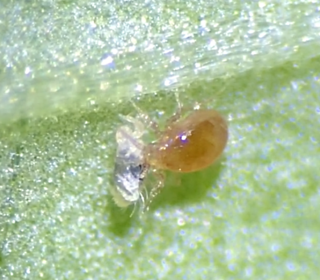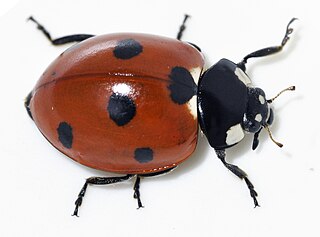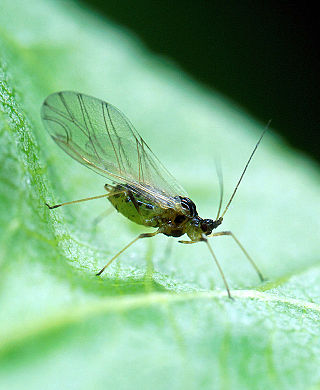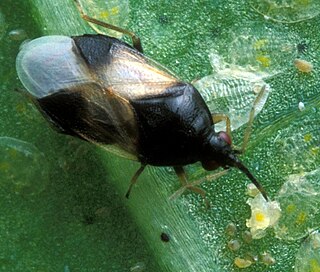
Biological control or biocontrol is a method of controlling pests, whether pest animals such as insects and mites, weeds, or pathogens affecting animals or plants by using other organisms. It relies on predation, parasitism, herbivory, or other natural mechanisms, but typically also involves an active human management role. It can be an important component of integrated pest management (IPM) programs.

Hemiptera is an order of insects, commonly called true bugs, comprising over 80,000 species within groups such as the cicadas, aphids, planthoppers, leafhoppers, assassin bugs, bed bugs, and shield bugs. They range in size from 1 mm (0.04 in) to around 15 cm (6 in), and share a common arrangement of piercing-sucking mouthparts. The name "true bugs" is often limited to the suborder Heteroptera.

Tetranychus urticae is a species of plant-feeding mite generally considered to be a pest. It is the most widely known member of the family Tetranychidae or spider mites. Its genome was fully sequenced in 2011, and was the first genome sequence from any chelicerate.

The genus Orius consists of omnivorous bugs in the family Anthocoridae. Adults are 2–5 mm long and feed mostly on smaller insects, larva and eggs, such as spider mites, thrips, jumping plant lice, and white fly, but will also feed on pollen and vascular sap.

The Phytoseiidae are a family of mites which feed on thrips and other mite species. They are often used as a biological control agent for managing mite pests. Because of their usefulness as biological control agents, interest in Phytoseiidae has steadily increased over the past century. Public awareness of the biological control potential of invertebrates has been growing, though mainly in the US and Europe. In 1950, there were 34 known species. Today, there are 2,731 documented species organized in 90 genera and three subfamilies.

Psylla pyri, commonly known as the pear psylla or pear psyllid, is an insect in the family Psyllidae. Originating in Europe and Asia, it has spread to North America. It is a pest of pear trees, sucking the sap, damaging the foliage, flowers and fruit and diminishing the crop.

Coccinellidae is a widespread family of small beetles. They are commonly known as ladybugs in North America and ladybirds in the United Kingdom; "lady" refers to mother Mary. Entomologists use the names ladybird beetles or lady beetles to avoid confusion with true bugs. The more than 6,000 described species have a global distribution and are found in a variety of habitats. They are oval beetles with a domed back and flat underside. Many of the species have conspicuous aposematic (warning) colours and patterns, such as red with black spots, that warn potential predators that they taste bad.

Myzus persicae, known as the green peach aphid, greenfly, or the peach-potato aphid, is a small green aphid belonging to the order Hemiptera. It is the most significant aphid pest of peach trees, causing decreased growth, shrivelling of the leaves and the death of various tissues. It also acts as a vector for the transport of plant viruses such as cucumber mosaic virus (CMV), potato virus Y (PVY) and tobacco etch virus (TEV). Potato virus Y and potato leafroll virus can be passed to members of the nightshade/potato family (Solanaceae), and various mosaic viruses to many other food crops.

Orius insidiosus, common name the insidious flower bug, is a species of minute pirate bug, a predatory insect in the order Hemiptera. They are considered beneficial, as they feed on small pest arthropods and their eggs. They are mass-reared for use in the biological control of thrips.

Neoseiulus cucumeris, the cucumeris mite, is a species of predatory mite in the family Phytoseiidae. It is used in biological pest control of western flower thrips in cucumber and some other greenhouse crops.

Coleomegilla maculata, commonly known as the spotted lady beetle, pink spotted lady beetle or twelve-spotted lady beetle, is a large coccinellid beetle native to North America. The adults and larvae feed primarily on aphids and the species has been used as a biological control agent. Based on name connotation and to avoid confusion with other species also called "spotted ladybeetle", spotted pink ladybeetle is probably the most appropriate common name for this species.

Chrysoperla carnea, one of the species of common green lacewing, is an insect in the Chrysopidae family. Although the adults feed on nectar, pollen and aphid honeydew, the larvae are active predators and feed on aphids and other small insects. It has been used in the biological control of insect pests on crops.

The common flowerbug is a common minute pirate or flower bug.

Heterotoma planicornis is a species of bug from Miridae family.

Eriosoma lanigerum, the woolly apple aphid, woolly aphid or American blight, is an aphid in the superfamily Aphidoidea in the order Hemiptera. It is a true bug and sucks sap from plants.
Dicyphus hesperus is a species of true bug in the family Miridae. It is a generalist predator of other insects and also feeds on plant tissues. It is native to North America and has been used there in biological control of agricultural pests, especially whitefly on tomatoes.
Macrolophus caliginosus is a species of true bug in the family Miridae. It is omnivorous and both preys on insects and feeds on plant tissues. It is used in Europe in the biological control of whitefly in tomatoes grown under glass.
Colophina clematis is a species of aphid in the woolly aphid subfamily, Eriosomatinae, native to Japan. This woolly aphid has the distinction of being the first species of aphid to have been identified as having a "soldier" caste. First instar nymphs of this type are able to protect the aphid colony, killing the larvae of predatory ladybirds, hoverflies and the flower bug Anthocoris nemoralis.
Deraeocoris brevis is a species of predatory plant bug in the family Miridae. It is native to North America where it feeds on plant pests in apple and pear orchards.
Cacopsylla pyricola, commonly known as the pear sucker, is a true bug in the family Psyllidae and is a pest of pear trees (Pyrus). It originated in Europe, was introduced to the United States in the early nineteenth century and spread across the country in the next century.















